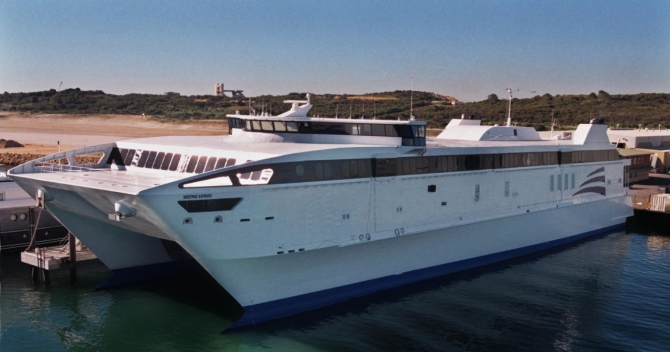Westpac Express (T-HSV-4676)
2001–
The first U.S. Navy ship named Westpac Express.
(T-HSV-4676: displacement 2,118; length 331.3'; beam 87.5'; draft 14.1'; speed 35 knots; complement 14 plus troop 970; class Westpac Express)
Westpac Express (T-HSV-4676) was completed in 2001 at Henderson, Western Australia, by Austal, Ltd.

Westpac Express is capable of sustaining loaded speeds of 35 knots, and can rapidly deploy most of a marine battalion -- up to 970 marines plus vehicles and equipment -- in a single lift. The Military Sealift Command (MSC) first chartered her to operate with the III Marine Expeditionary Force (MEF) in July 2001 for a ‘proof of concept’ period, subsequently extending the charter. Originally described as a “theatre support vessel,” the MSC gradually shifted her role and now more commonly refers to Westpac Express as a “high speed connector.”
“Instead of a two week process to deploy by air lift,” CW05 Roger G. Rose, Surface Embarkation Officer, III MEF G-4, Strategic Mobility Office, evaluated one such deployment in 2006, “Westpac Express moved the unit’s 843 marines, 63 vehicles, and 27 containers of baggage and cargo in 30 hours. Instead of a price-tag of over $500,000 for one-way transportation requiring at least 16, C-17 airlifts, Westpac Express did the round trip lift for $130,000.”
Westpac Express operated with American, Indonesian, Japanese, Singaporean, and Thai armed forces in Cobra Gold 2006, a combined, joint, multilateral, training exercise. The Thailand phase ran from 15 to 26 May 2006 and included a computer-simulated staff exercise, field training exercises, numerous humanitarian and civic assistance projects, and exercise-related construction projects designed to improve multinational interoperability and strengthen international relationships. More than 175 marines and sailors, together with their vehicles and containers of equipment, boarded Westpac Express at the port of Kin Red near the III MEF base at Camp Hansen, Okinawa, on 8 May. The marines comprised primarily Kilo Battery, Capt. Joshua B. Chartier, USMC, in command, 3rd Battalion, 11th Marine Regiment, deployed from the Air Ground Combat Centre at Twentynine Palms, Calif., and took part in jungle-warfare and small-arms training in southeast Thailand. The Hawaii-based Combat Logistics Platoon 3 provided maintenance support and engineer site improvements.
A magnitude 9.0 (Mw) undersea megathrust earthquake occurred off the Tōhoku region of Honshū, Japan, at 1446 on 11 March 2011. The earthquake triggered tsunami waves that reached more than 100 feet in height at places, and caused nearly 25,000 casualties, including more than 15,000 killed. The United States initiated Operation Tomodachi, from the Japanese Tomodachi Sakusen [—Operation Friend(s)] to provide humanitarian relief to the victims. A total of 24,000 U.S. servicemembers, 189 aircraft, and 24 ships served in Tomodachi (12 March–4 May 2011), including Westpac Express.
From the Korean peninsula, Capt. Adam Parsons, the ship’s civilian master, led Rear Adm. Byeung K. Lee, Vice Commander Republic of Korea Fleet Operations, and Rear Adm. Jae Ok Shim, Commander Air Wing 6, Republic of Korea Navy, on a tour of the vessel on 20 January 2013. In 2014 and 2015, Westpac Express continued to transport III Marine Expeditionary Force marines and their equipment to and from exercise areas.
Detailed history pending.
Mark L. Evans
11 January 2016


